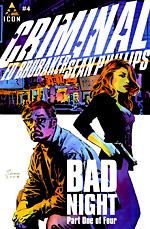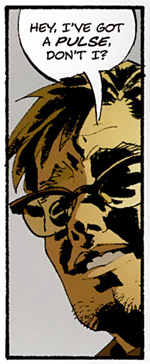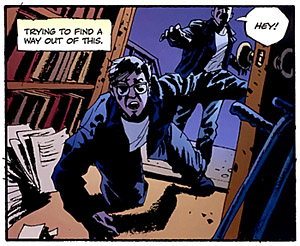 Written by Ed Brubaker
Written by Ed Brubaker
Art by Sean Phillips
40 pages, color
Published by Marvel Comics
There are some books on the market that I think people take for granted—it’s out there, it’s entertaining, it will be waiting for you whenever you’re ready for another dose. So often, though, those books are the ones that people should be talking up a lot more. Books like Criminal aren’t just something you should stop by and read every once in a while, they’re books that you should celebrate every time a new issue hits the stands. With Criminal Vol. 2 #4 now out, it’s the start of a brand-new story—so what are you waiting for?
 Jacob usually doesn’t sleep until the sun comes up, an irritating form of insomnia. So while he often spends the evening working on his newspaper strip "Frank Kafka, P.I." he also ends up awake and about in those late hours of the night, heading through the city, maybe hitting a diner. When his path leads him to a bickering couple, though, he certainly wouldn’t have expected to get drawn into their lives. But that’s the risk you run when you admit your former life as a counterfeiter to just anyone, now isn’t it?
Jacob usually doesn’t sleep until the sun comes up, an irritating form of insomnia. So while he often spends the evening working on his newspaper strip "Frank Kafka, P.I." he also ends up awake and about in those late hours of the night, heading through the city, maybe hitting a diner. When his path leads him to a bickering couple, though, he certainly wouldn’t have expected to get drawn into their lives. But that’s the risk you run when you admit your former life as a counterfeiter to just anyone, now isn’t it?
One thing that really struck me about this issue of Criminal is how Ed Brubaker sets out to deliberately subvert the reader’s expectations in places. Is this a story about an arsonist? Maybe it’s about a nobody who gets pulled into a feuding couple’s relationship? Wait, is it about a scam? Each new scene adds another spin to the narrative, another moment of, "Hey, I didn’t see that coming." That’s one of the things I appreciate about Criminal; I’ve heard criticisms in the past that most stories in the crime genre are by-the-book and predictable, but Brubaker goes out of his way to make that anything but the case.
Brubaker’s characters in Criminal are always more than they initially appear on the surface. Jacob, who in past stories appeared as a background character (his bringing back characters like this works well for people who have read all of Criminal, but at the same time is never necessary and thus keeps it accessible to new readers), is definitely more than he appears at first. I found myself fascinated by each new piece of information that he reveals to the audience; for someone that initially starts off as a slightly meek, innocent character, my opinion of him couldn’t help but change greatly by the end of the first issue. Best of all, because all we really have to go on is Jacob’s statements, there’s a great sense of "Bad Night" being told by an unreliable narrator. How much of what he’s saying is true? Or even more importantly, how much is Jacob leaving out?
 I’ve always really liked how Sean Phillips draws faces, a rough, sketchy style that really brings expressions and features to life. For all of the hyper-realized, photo-rendered faces that seem to decorate comics these days, it’s art like Phillips that seems the most realistic to me. Some panels are a little sketchier than others, with the detail looser than normal, but on the whole it really works for me, especially with how Phillips pays attention to the finer details of the art, drawing scattered papers and leaning books in a way that is anything but uniform or unrealistic. He’s also able to pack a lot onto a single page; by using a uniform, three horizontal-strips of panels on every page, it’s not uncommon to see as many as ten panels on a page, each of varied width so to show exactly as much as is needed but still have room for everything else. Why draw a huge, half-a-page-wide panel of a person’s reaction shot when a narrow sliver will work just as well?
I’ve always really liked how Sean Phillips draws faces, a rough, sketchy style that really brings expressions and features to life. For all of the hyper-realized, photo-rendered faces that seem to decorate comics these days, it’s art like Phillips that seems the most realistic to me. Some panels are a little sketchier than others, with the detail looser than normal, but on the whole it really works for me, especially with how Phillips pays attention to the finer details of the art, drawing scattered papers and leaning books in a way that is anything but uniform or unrealistic. He’s also able to pack a lot onto a single page; by using a uniform, three horizontal-strips of panels on every page, it’s not uncommon to see as many as ten panels on a page, each of varied width so to show exactly as much as is needed but still have room for everything else. Why draw a huge, half-a-page-wide panel of a person’s reaction shot when a narrow sliver will work just as well?
Criminal should be getting a lot more attention that it does. It’s a sharp, smart comic that always entertains and intrigues. If all comics were this well-produced, I don’t think it would be such an uphill battle at times to convince the general public that comics aren’t always for children. In addition to Criminal Vol. 2 #4 being the start of a new story, all the previous issues to date are collected in three handsome volumes. Of course, if you skip the individual issues, you’ll miss out on all of the bonus material; this latest issue, for example, contains an interview with Hard Case Crime publisher Charles Ardai, and an article by Bob Calhoun about the lack of "pro-wresting noir." Trust me, check it out. You’ll be quite pleased.
